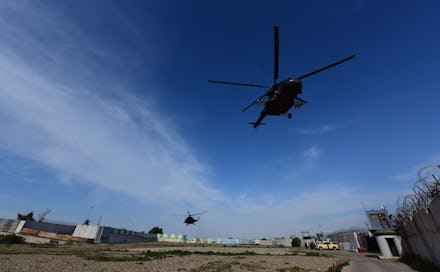Will coronavirus fracture the United States into regional blocs?

Depictions of American federalism gone haywire have a storied history in near-future science fiction. In Paolo Bacigalupi’s 2015 novel The Water Knife, southwestern states militarize their borders, raise armies, and wage war over shrinking water resources. Neal Stephenson’s epic 2019 novel Fall depicted a country divided into a coastal democracy and a tyrannical heartland theocracy called “Ameristan.” In the 1981 film Escape from New York, Manhattan is a Supermax prison surrounded by towering walls. When Americans imagine a dystopian future, the idea of regions fractured by conflict looms large.
The coronavirus pandemic has brought these concepts out of the realm of fantasy. In the absence of a cohesive federal response to the crisis, states have taken it upon themselves to form regional blocs. Powerful blue state regions, including the West Coast and the Northeast, have taken the lead.
“We have seven states that we’re working with. ... The virus doesn’t understand state boundaries,” said New York Gov. Andrew Cuomo (D) at a press conference Tuesday, as a slide showed an image of New York, New Jersey, Connecticut, Pennsylvania, Rhode Island, and Delaware. The states announced Monday that they will work together on plans to coordinate the reopening of their economies. “The virus can get on Amtrak, the virus can get on a plane. We’re all connected,” Cuomo continued, emphasizing the need for states with shared borders to work together.
California, Washington, and Oregon have also announced a partnership to focus on fighting the virus and reopening their economies together. These multi-state coordination projects are forming against the backdrop of President Trump claiming that he has the “ultimate authority” over when states can reopen. “When somebody is the president of the United States, the authority is total. And that’s the way it’s gotta be. … It’s total,” he continued. “The governors know that.” In a later tweet, Trump compared governors of states that aren’t interested in reopening on his schedule to mutineers in the 1962 film Mutiny On The Bounty.
Constitutional experts interviewed by The Washington Post disagree with the president’s interpretation of his power. His framing goes against one of the foundational principles of America: federalism. In his press conference, Cuomo quoted Alexander Hamilton, the Founding Father who wrote that “state governments possess inherent advantages, which will ever give them an influence and ascendancy over the national government, and will forever preclude the possibility of federal encroachments.”
Trump does not have the authority to dictate when individual states will reopen their economies, and Cuomo made clear that he and the other states in his regional bloc will be following their own timetables. Trump is not a “king,” Cuomo declared on CNN.
So far, this is all theoretical. The federal government has issued a lot more partisan bluster than it has actual guidelines about re-opening, so neither the Acela corridor governors nor the West Coast bloc have actually had to assert their own power against the feds. Instead, they’ve been filling the vacuum left by Trump’s failure to issue strong guidelines.
Picture thousands of cars backed up on I-80, as the California Highway Patrol takes the temperature of every driver coming in from Nevada.
In this regard, these blue-state governors have been playing the role usually occupied by red states under the Obama administration. Faced with far-reaching federal programs like Obamacare, red states at the time asserted their federalist muscle and fought President Barack Obama every step of the way. The difference, of course, is that in that case, governors were blocking an expansion of health care that stemmed from a specific policy that’d been signed into law; this time around, the regional leaders are stepping in to fill the void of policymaking coming from the White House.
As the pandemic rolls on, however, Cuomo, California Gov. Gavin Newsom (D), and other public health-minded governors will almost certainly reject guidance from the White House to reopen businesses and schools if the Trump administration suggests doing so before medical experts feel that it’s safe. Other governors probably will not defy the federal government. That potentially opens up a fascinating situation in which states with Republican and Democratic governors form separate and opposing blocs.
Imagine, for example, if more governors follow the lead of South Dakota’s Republican leader Kristin Noem, who is just one of eight governors nationwide who have refused to issue stay-at-home orders. Will a coalition of like-minded obstinates form to counter the coastal leaders?
If Trump demands that states re-open, and the West Coast states refuse, a conservative-minded Mountain West Economic Development Zone incorporating Idaho, Montana, the Dakotas, and Wyoming could jump at the chance to follow White House orders. So might a neo-confederacy of Gulf states, aligned with conservative Midwest bastions like Indiana. It could become like regional musical chairs, with millions of Americans suddenly living under vastly different scenarios than those in neighboring states.
And then, say if coronavirus were to flare up in the newly reopened states, the West Coast bloc could conceivably close its entire eastern border to limit exposure to new cases. Picture thousands of cars backed up on I-80, as the California Highway Patrol takes the temperature of every driver coming in from Nevada. There could be regional caste systems based on levels of herd immunity and the availability of routine serological testing, with immunity passports required to go to work or cross state lines.
Again, this is all theoretical at this stage. But the burgeoning rebellion by liberal governors seeking to protect their residents’ health from an erratic and increasingly domineering president begs the question of how else such regional alliances could play out.
As Cuomo said, the pandemic doesn’t respect intra-state boundaries. Once states begin taking radically different approaches to mitigation and containment, the country could begin fracturing into a series of discrete ideological and immunological zones. It’s a sci-fi outcome for a sci-fi pandemic.